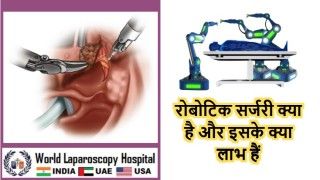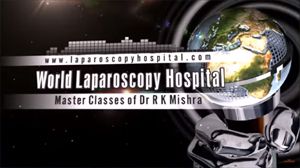Laparoscopic Repair: Restoring Abdominal Wall Integrity in Rectus Diastasis with Incisional Hernia
Add to
Share
1,349 views
Report
2 years ago
Description
Introduction: Rectus diastasis is a condition characterized by the separation of the abdominal muscles, specifically the rectus abdominis muscles. It often occurs as a result of pregnancy, weight gain, or abdominal surgeries. When rectus diastasis is accompanied by an incisional hernia, where abdominal contents protrude through a previous surgical incision, it can lead to functional and aesthetic concerns. In such cases, laparoscopic repair offers a minimally invasive solution to restore abdominal wall integrity and improve patient outcomes. This comprehensive article will delve into the details of laparoscopic repair for rectus diastasis with incisional hernia, its benefits, and considerations for this surgical approach. Procedure: Laparoscopic repair for rectus diastasis with incisional hernia is performed under general anesthesia. It involves making small incisions in the abdomen through which specialized instruments and a laparoscope (a thin, illuminated camera) are inserted. The laparoscope provides a magnified view of the abdominal cavity, allowing the surgeon to visualize the hernia defect, rectus diastasis, and surrounding structures. The surgeon starts by reducing the hernia, carefully pushing the protruding abdominal contents back into the abdominal cavity. The next step involves repairing the rectus diastasis. This is achieved by bringing the separated rectus abdominis muscles back together, typically through the use of sutures or synthetic mesh reinforcement. The mesh provides added strength and support to the weakened abdominal wall, reducing the risk of recurrent hernia and ensuring long-term stability. Benefits of Laparoscopic Repair for Rectus Diastasis with Incisional Hernia: Minimally invasive approach: Laparoscopic repair offers several advantages over open surgery, including smaller incisions, reduced postoperative pain, faster recovery times, and improved cosmetic outcomes. The smaller incisions result in less tissue trauma, decreased blood loss, and a lower risk of surgical site infections. Restoration of abdominal wall integrity: By repairing both the rectus diastasis and the incisional hernia, laparoscopic surgery restores the integrity of the abdominal wall. This leads to improved functionality, decreased risk of complications, and enhanced patient satisfaction. Enhanced visualization and precision: The laparoscopic approach provides the surgeon with a high-definition, magnified view of the surgical site, enabling precise identification and repair of the hernia defect and rectus diastasis. This results in improved outcomes and reduced risks associated with incomplete repairs. Considerations for Laparoscopic Repair for Rectus Diastasis with Incisional Hernia: Patient selection: Laparoscopic repair is suitable for most patients with rectus diastasis and incisional hernia. However, individual patient factors, such as the size and complexity of the hernia, overall health, and previous surgeries, may influence the decision for laparoscopic repair. The surgeon will assess these factors to determine the most appropriate approach. Surgeon expertise: Laparoscopic repair for rectus diastasis with incisional hernia requires specialized training and expertise. It is crucial to choose a surgeon who is experienced in laparoscopic techniques to ensure optimal outcomes and minimize the risk of complications. Postoperative care and recovery: Following laparoscopic repair, patients may experience mild discomfort, bruising, or swelling, which can be managed with pain medications and proper wound care. The surgeon will provide specific instructions on postoperative care, physical activity, and follow-up visits to monitor the healing process. Recovery and Follow-up: Patients undergoing laparoscopic repair for rectus diastasis with incisional hernia generally experience a shorter recovery period compared to open surgery. The smaller incisions result in less postoperative pain, reduced risk of wound complications, and faster return to normal activities. Patients are typically encouraged to engage in light physical activity soon after surgery and gradually increase their level of activity as advised by their surgeon. Follow-up appointments with the surgeon are essential to monitor the healing process and ensure optimal recovery. The surgeon will evaluate the surgical site, assess the integrity of the abdominal wall, and address any concerns or questions that the patient may have. Regular follow-up visits also allow for the early detection of any potential complications and prompt intervention if necessary. In addition to restoring abdominal wall integrity and improving functionality, laparoscopic repair for rectus diastasis with incisional hernia can have a positive impact on the patient's quality of life. By addressing both the aesthetic and functional aspects of the condition, this surgical approach aims to enhance patient satisfaction and overall well-being. Laparoscopic repair is a minimally invasive surgical procedure designed to restore abdominal wall integrity in individuals with rectus diastasis accompanied by an incisional hernia. Rectus diastasis refers to the separation of the abdominal muscles, particularly the rectus abdominis, which commonly occurs after pregnancy, weight gain, or previous abdominal surgeries. When rectus diastasis is compounded by an incisional hernia, where abdominal contents protrude through a prior surgical incision, it can lead to functional impairment and aesthetic concerns. During the laparoscopic repair procedure, the patient is placed under general anesthesia. Small incisions are made in the abdomen to allow for the insertion of specialized instruments and a laparoscope—a thin, illuminated camera that provides a magnified view of the surgical site. With enhanced visualization, the surgeon proceeds to reduce the hernia by carefully returning the protruding abdominal contents back into the abdominal cavity. Next, the surgeon addresses the rectus diastasis by bringing the separated rectus abdominis muscles back together. This can be achieved through the use of sutures or synthetic mesh reinforcement, which provides added strength and support to the weakened abdominal wall. By repairing both the rectus diastasis and the incisional hernia, laparoscopic repair restores abdominal wall integrity, improves functionality, and reduces the risk of complications. The benefits of laparoscopic repair for rectus diastasis with incisional hernia include smaller incisions, reduced postoperative pain, faster recovery times, and improved cosmetic outcomes compared to open surgery. The minimally invasive approach minimizes tissue trauma, blood loss, and the risk of surgical site infections. Additionally, laparoscopic repair offers enhanced visualization and precision, allowing the surgeon to perform precise repairs and reduce the chances of incomplete repairs or recurrent hernias. Patient selection for laparoscopic repair is based on various factors such as the size and complexity of the hernia, overall health, and previous surgical history. It is essential to choose a surgeon experienced in laparoscopic techniques to ensure optimal outcomes and minimize the risk of complications. Following the procedure, patients can expect a shorter recovery period, with gradually increasing physical activity as advised by the surgeon. Regular follow-up appointments are crucial to monitor the healing process, address any concerns, and detect potential complications early. Conclusion: Laparoscopic repair is an effective and minimally invasive approach for restoring abdominal wall integrity in cases of rectus diastasis with incisional hernia. This procedure offers numerous benefits, including smaller incisions, reduced postoperative pain, improved cosmetic outcomes, and a faster recovery compared to open surgery. It is crucial for patients to consult with a qualified surgeon experienced in laparoscopic techniques to determine the most suitable treatment approach based on their individual condition and medical history. By choosing laparoscopic repair, patients can expect a successful resolution of their rectus diastasis and incisional hernia, resulting in improved abdominal wall functionality and enhanced overall well-being.
Similar Videos






